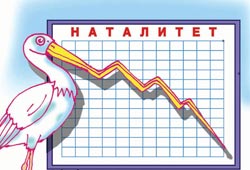Births and Deaths
 The results of the recently completed census have yet to be completed, but one is already known – there are fewer people in Serbia. Every year a town of about forty thousand inhabitants disappears. Warnings have come true, warnings of demographers who have been sending dramatic messages primarily to authorities to do everything possible in order to approach this problem seriously, and, above all, influence fertility rate increase by economic measures.
The results of the recently completed census have yet to be completed, but one is already known – there are fewer people in Serbia. Every year a town of about forty thousand inhabitants disappears. Warnings have come true, warnings of demographers who have been sending dramatic messages primarily to authorities to do everything possible in order to approach this problem seriously, and, above all, influence fertility rate increase by economic measures.
If the trend of declining birth rate continues in Serbia, as it is estimated it will, one whole city size of Belgrade, which now has a population of 1.6 million, will disappear by 2050. In Europe, Bulgaria and Hungary have even worse records than Serbia. Our country has been facing decline in population since the late 19th century and the challenges of modern times have introduced even greater problems. A drastic decrease was recorded after World War II, when 1.7 million people were killed and later years have brought issues that have no major solutions. In the years of postwar reconstruction and accelerated industrialization and modernization, the population decline was registered in rural areas, with many villages abandoned while cities grew. When it comes to family, it is certainly worth comparing the traditional with the contemporary one because the differences are huge. While woman was a pillar of the traditional family, today's woman is often torn between work and home commitments. Therefore, many women, having chosen a career, decided not to have children, or possibly allow themselves to have only one child. Reproduction rate in Serbia is below 1, meaning that woman does not give birth to two children on average as it is necessary for long-term replacement of generations. The people increasingly opt to marry later in life which also contributes to the falling number of children. This is why our country has more and more persons older than 65. The negative impact on the declining birth rate was also caused by the most recent wars in former Yugoslavia, followed by the economic crisis. This motivated young people to leave this area, which certainly influenced the further decline in birth rate. One third or about 4 million Serbs live abroad. Experts point out that one of the causes is also abortion, because the number of abortions annually performed in Serbia is about 200,000. Traditional religious communities are trying to encourage young people so that the parenting again becomes one of the important things in the life of every individual. As the late Bishop Sava of Sumadija used to say: "It is necessary to treat the contemporary, but in fact the oldest human disease, and that is selfishness. Parents often do not opt to have children for purely selfish reasons, not wanting to disrupt their comfortable world. Giving birth and raising children is a "sacrifice" that modern man is not prepared to make. That truth of this statement is confirmed by the records showing that there are fewer marriages in Serbia, and that one third of married couples has no children. In order to improve the situation, the state pays a one-time parental allowance for the first child and in monthly installments for every subsequent child, and those with lower income are entitled to the children's allowance, but the amounts are rather low, especially if one bears in mind the poor economic situation, the continuing rise in prices and increasing unemployment. Local communities provide assistance as much as they can, but it is generally very modest. This is why a complete solution is expected of the state, and the results of the latest census should encourage the adoption of appropriate measures that would in turn encourage childbirth and assist families in raising their children.
Source: glassrbije.org

